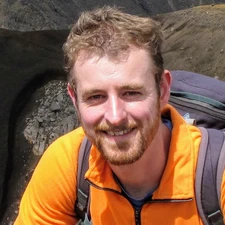Mark J. Hoggard

GD Geodynamics
The 2021 Division Outstanding Early Career Scientist Award is awarded to Mark J. Hoggard for outstanding research in connecting observations at the Earth’s surface to its deep interior.
Mark Hoggard is a highly interdisciplinary geologist and geodynamicist working at the forefront of research connecting observations at the Earth’s surface to its deep interior. He has made fundamental and enduring contributions to our understanding of mantle convection, lithosphere structure and dynamics, and mineral resource emplacement.
In Hoggard’s PhD work, he demonstrated that sub-lithospheric processes contribute significantly to present- day topography and that these act on shorter spatial wavelengths and timescales than previously thought. This research challenges conventional views of the mantle convection process and has generated lively debate in the global geophysics community. Moreover, his recent work on topographic swells is leading to a major reappraisal of Earth’s budget by significantly increasing the estimated heat flux associated with mantle plumes.
Most recently, Hoggard’s deep insight into the dynamics of Earth’s lithosphere has led him to another exciting and seminal discovery, namely that major base metal deposits are preferentially located at the edge of cratonic lithosphere. This work demonstrates that cratons are remarkably stable over Earth’s history and provides a treasure map for prospecting new, high-yield reservoirs of copper, lead, zinc, and nickel. It is not surprising, given the crucial importance of these metals for sustainable development and efforts to transition to clean- energy technologies, that the work has also received widespread and international media interest.
Hoggard’s encyclopedic knowledge and deep understanding of the fields of geology, geochemistry, and geophysics allow him to leverage a multitude of observations and combine them in highly novel ways to probe Earth’s interior. Indeed, his work is leading to a renaissance of interest in Earth structure and dynamics – and their connection to the surface – by demonstrating the relevance of these topics to areas well beyond traditional applications. He is a superb and widely supported choice for the Outstanding Early Career Scientist Award for the Geodynamics Division.
